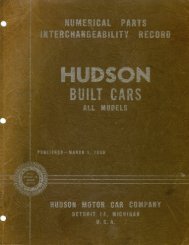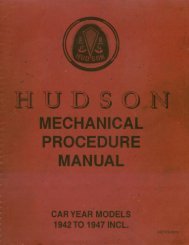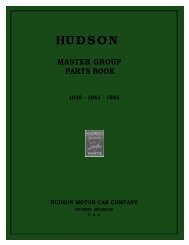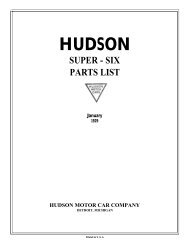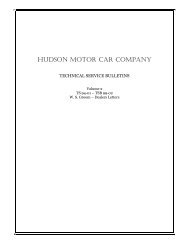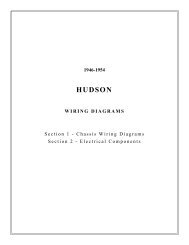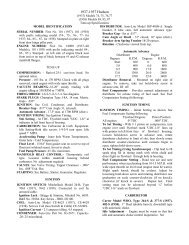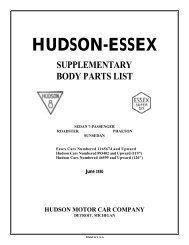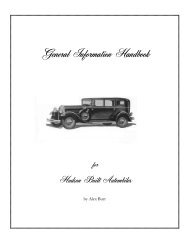1914 Delco Junior System Care
1914 Delco Junior System Care
1914 Delco Junior System Care
Create successful ePaper yourself
Turn your PDF publications into a flip-book with our unique Google optimized e-Paper software.
INSTRUCTIONS<br />
FOR THE CARE OF<br />
<strong>1914</strong> JUNIOR<br />
<strong>Delco</strong> <strong>System</strong>s<br />
THE<br />
Dayton Engineering Laboratories Co.<br />
DAYTON, OHIO
<strong>1914</strong> <strong>Junior</strong> <strong>Delco</strong> <strong>System</strong><br />
What is known as the <strong>Delco</strong> <strong>Junior</strong> <strong>System</strong> is applied to the following cars:<br />
DESCRIPTION<br />
<strong>1914</strong> Buick Models B-24-25, B-36-37<br />
" Cartercar Model 7<br />
" Hudson Model 6-40<br />
" Keeton Model 4-35<br />
" Oakland Model 36<br />
" Oldsmobile Model 42<br />
" Paterson Models 32-33<br />
" Westcott Model 0-4<br />
This system includes the following units: A generator with a single<br />
armature, having two separate and electrically distinct windings, each with its<br />
own commutator, both commutators being mounted on the front end of the<br />
armature - a single field coil with two separate windings, one for cranking, the<br />
other for generating and provided with a cut-out relay mounted in the rear<br />
generator housing - a distributor and timer mounted in the front generator<br />
housing, an ignition coil and an ignition relay which are separate in some cases<br />
and combined in others-an ignition switch, and a 6-volt storage battery. The<br />
negative terminal of the storage battery and the negative side of the system are<br />
grounded to the frame of the car.<br />
Figures 1 and 2 are typical wiring and circuit diagrams of one of these<br />
systems and show clearly how the various parts are connected together.<br />
OPERATION<br />
The following cycle of operations is performed in getting the engine<br />
started: The ignition switch is turned on, so that the ignition coil is supplied<br />
with current from the dry cells and through the ignition relay. The path of this<br />
current is shown in red in the circuit diagram, Fig. 4. The starting lever or<br />
pedal, as the case may be, is pressed down part way; this will cause the<br />
brush-shifting rod "A" in the motor generator (see Fig. 6-C) to be drawn back,<br />
which mechanically closes the cut-out relay by means of the catch "F." (See<br />
Fig. 10). The armature will then revolve due to the current through the<br />
3
generator windings, the live portion of the circuit being indicated in<br />
red in the circuit diagram, Fig. 3. The lever or pedal is then pressed<br />
still further down and the starting gears meshed with the flywheel.<br />
When the gears are fully in mesh the top motor brush is lowered upon<br />
the commutator and just before this time the lower generator brush is<br />
raised by means of the catch "L" shown in Fig. 9. Current passing<br />
through the motor windings as indicated in red in the circuit diagram,<br />
Fig. 4, causes the motor to crank the engine over.<br />
CLUTCHES<br />
When the engine begins to fire the lever or pedal is allowed to slip<br />
back to its normal position and the gears are disengaged and the<br />
armature is driven by the pump shaft through the driving clutch. It<br />
should be noted further that during the cranking operation the armature<br />
is running about 20 times the speed of the engine and, therefore,<br />
much faster than the pump shaft. While this is occurring the generator<br />
clutch at the front of the motor generator is slipping. When the engine<br />
begins to fire, however, it begins to run fast enough to drive the<br />
armature faster than the pump shaft, but this is prevented by the<br />
slipping of the motor clutch, which continues until the gears are out<br />
of mesh with the flywheel. This explains the necessity of a starting<br />
and driving clutch on a system of this type. When the engine increases<br />
its speed to a point where the voltage of the generator is approximately<br />
71/2 volts, the cut-out relay closes and the generator begins to<br />
charge the storage battery. The charging circuit is shown in red in the<br />
circuit diagram, Fig. 3. The circuit for current used in lighting, mag,<br />
ignition and by the horn is shown in red in the circuit diagram, Fig. 5.<br />
MOTOR GENERATOR<br />
The motor generators are all essentially of one type, shown in<br />
section in Fig. 6-A, 6-B, 6-C. In some the starting clutch is mounted<br />
in the rear housing of the motor generator; in others it is mounted on<br />
a projection of the flywheel housing. The starting clutch, shown in<br />
Fig. 7, is so mounted that when the ring gear is just beginning to mesh<br />
with the armature pinion the stub gear is approximately 1/8" away<br />
from the flywheel teeth. The driving clutch is held to the front end of<br />
the armature shaft by a clamping washer with lugs that fit into slots in<br />
the clutch shell and armature shaft. This clamping washer is held to<br />
the shaft by a screw and lock washer. By reference to Fig. 8 this<br />
construction should be evident. As regards the operation of the motor<br />
generator several points should be carefully noted. First, the<br />
4
ush-shifting rod should be so adjusted that the cut-out relay is closed<br />
before the teeth in the ring gear of the starting clutch begin to mesh with<br />
the teeth on the armature pinion. Also, so that the top motor brush is not<br />
permitted to touch the motor commutator until the motor clutch stub<br />
gear is fully in mesh with the flywheel teeth. If the little catch "L"<br />
shown in Fig 9 is incorrectly assembled, so that it fails, to raise the<br />
lower generator brush slightly before the motor brush touches its<br />
commutator, the starter will crank at less than 30% of its normal<br />
cranking speed. The incorrect assembly is indicated in dotted line in<br />
Fig. 9, the correct assembly being indicated in full lines. If this catch<br />
has been incorrectly assembled it will be necessary to remove the lower<br />
plate that supports the lower brushes, and then while holding this catch<br />
in the proper position, slip the brush plate into place and fasten it with<br />
its two screws.<br />
CUT-OUT RELAY<br />
The cut-out relay is fastened firmly to the rear housing of the motor<br />
generator. A view of this relay as it would appear when seen from the<br />
rear is shown in Fig. 10. The catch "F" mechanically closes the relay<br />
contacts and permits current from the storage battery to flow through<br />
the generator and thus cause. the armature to rotate in a clockwise<br />
direction when viewed from the front end. The cut-out relay should<br />
have the leads to its terminals so fastened that they do not project above<br />
the tops of the relay terminals; otherwise they are liable to ground<br />
against the metal top cover of the motor generator. Particular attention<br />
should be given to this point when taking apart or assembling the motor<br />
generator.<br />
THE ADJUSTMENTS, OF THE BRUSH-SHIFTING ROD with respect<br />
to the yoke which pulls the starting clutch back, governs the time<br />
at which the cut-out relay closes, the lower generator brush is raised<br />
from the commutator, and the top motor brush is lowered upon the<br />
commutator, relative to the time at which the starting clutch gears mesh<br />
with the armature pinion, and the flywheel teeth, respectively. It-should<br />
be noted that the generators which have the starting clutch mounted in<br />
the rear motor generator housing have no adjustment of the rod with<br />
relation to the yoke which operates the starting clutch; and that the<br />
adjustment is merely to make sure that the starting clutch gears will be<br />
fully in mesh with flywheel teeth. On the other hand, on the cars where<br />
the starting clutch gears are mounted in the flywheel housing the<br />
adjustment provides for a change in the relative time of operation of the<br />
brushes and the clutch, and particular care should be taken to make sure<br />
10
taken to make sure that these operations are performed in the proper sequence.<br />
In both cases the rod should be so adjusted that the starting clutch clears the<br />
flywheel teeth when the starting lever or pedal is<br />
in the normal position.<br />
DISTRIBUTOR<br />
The distributor is mounted in the front generator housing and is shown in<br />
Fig. 6-B and 6-C. This figure will make clear the general features of its<br />
assembly. To change the timing loosen the screw in the top of the distributor<br />
shaft and turn the assembly around until it is in the proper position, then<br />
tighten down the screw again. For information on the timing of any car refer<br />
to the manufacturers of that car.<br />
One point regarding this ignition system should be called to attention and<br />
that is the effect of a ground on the dry cell circuit, Such a ground will cause<br />
the "mag." ignition to stop altogether and yet not affect the dry cell ignition<br />
itself. Views of the coil and ignition relay are shown in Fig. 11 and of the coil<br />
box in Fig. 12, the latter containing both coil and ignition relay as previously<br />
explained.<br />
IGNITION SWITCH<br />
The ignition switches used are of two types, one for ignition only, shown in<br />
Fig. 13, and the other for both lights and ignition, shown in Fig. 14. The<br />
sectional views will make their construction plain; and a careful examination<br />
as to the condition and adjustment of their contacts is about all the attention<br />
they will need.<br />
13
INSTALLING AMMETER<br />
If it is desired to install an ammeter in connection with this system the<br />
following procedure is recommended: Referring to Fig. 15 it will be<br />
noted that a brass strap connects the two terminal Nos. 1 and 2. On<br />
some of the machines this strap is inside of the frame as indicated by<br />
the letter " B " and in others on the outside as in " A. " If this strap is on<br />
the inside of the motor generator it will be necessary to remove the<br />
motor generator from the car and take it apart to cut the strap. Where<br />
the strap is on the outside, as in "A," it can be cut with a hack saw<br />
without removing the motor generator from the car. The negative<br />
terminal of the storage battery should, however, be disconnected before<br />
attempting the cut. After the strap is cut the leads attached to the two<br />
ammeter terminals should be connected to the two terminals previously<br />
connected by the brass strap. In all cases the leads originally connected<br />
to these two terminals must remain undisturbed. The installation of the<br />
ammeter requires that the two additional leads must be attached to the<br />
Motor-generator terminals. Should it be found that the ammeter indicates<br />
“discharge” instead of “charge” simply reverse the connections at<br />
16
the back of the ammeter. For such an installation it is recommended that the<br />
meter be of the "deadbeat" type, having a zero center and approximately 30<br />
amperes charge and discharge scale. The meter connected in this way will<br />
indicate the net charging current, but will not indicate the discharge current<br />
taken by the motor during the cranking operation.<br />
OVERHAULING MOTOR GENERATOR<br />
With regard to overhauling the motor generator it is advisable to have this<br />
done about once a year-the various parts taken out, thoroughly cleaned,<br />
bearings examined and replaced if unduly worn - the generator clutch taken<br />
apart, cleaned out and repacked with grease - the commutators trued up, if<br />
they are rough or eccentric. Mica on the generator commutator should be<br />
undercut and the brushes replaced and refitted if necessary. Details are given<br />
in another article for the work of undercutting the mica and refitting the<br />
brushes. If it is suspected that any portions of the system are grounded, the<br />
system can be tested out by the use of a drop light; and complete information<br />
regarding the method to be used on this subject is given in another article.<br />
TESTING CHARGING RATE<br />
To test the charging rate disconnect the lead from the field to the top<br />
carbon brush and then connect the two meter terminals respectively to this<br />
lead and to the brush to which it was formerly connected. The meter used for<br />
this purpose should preferably have a zero center and a range of 30 amperes<br />
charge and discharge. When the meter is connected into the circuit and in the<br />
manner described above, it will indicate the gross charging rate produced by<br />
the generator. The charging rate of the generators of the type used on these<br />
systems has a maximum of from 14 to 20 amperes-these figures being<br />
approximately correct for the generator when hot.<br />
TIMING IGNITION<br />
The ignition system of these cars call for little special attention. The connections<br />
should be gone over occasionally to make sure that they are clean and<br />
tight. The resistance unit "B" on these systems is shown in Fig. 6. The timing<br />
of these systems is accomplished, by setting the timing cam adjustment<br />
assembly in the proper position so that when the rotor contact is approximately<br />
under the No, 1 terminal of the distributor head the "mag." contacts<br />
are just beginning to break when the flywheel has gone about one or two<br />
17
inches past top dead center with the No. 1 cylinder in firing position,<br />
(This with the spark lever set at full retard). These instructions are only<br />
intended to be approximate, and details for any car can be obtained<br />
upon application of the manufacturer of that car. After the timing cam<br />
adjustment assembly has been properly set, it is fastened in position by<br />
tightening down the center screw firmly. For further information regarding<br />
the ignition systems and the best methods of adjusting the<br />
same, refer to another article on <strong>Delco</strong> Ignition. <strong>System</strong>s.<br />
LUBRICATION<br />
As regards the lubrication of these systems, the following points<br />
should be observed: By removing the distributor head and rotor it will<br />
be possible to drop a few drops of good light cylinder oil in the top<br />
bearing. Reference to Fig. 6 will make the location of this bearing<br />
plain.. The lower distributor bearing is lubricated by grease in the<br />
generator housing; and no particular attention need be paid to it excepting<br />
to see that the front distributor housing is kept supplied with a<br />
reasonable amount of grease. The grease in the front generator housing<br />
also lubricates the generator clutches and excepting that it will be<br />
necessary to repack the clutches about once a year, the only attention<br />
necessary to the clutches will be to keep a good supply of grease in the<br />
front generator housing. <strong>Care</strong> should be taken not to put in too much<br />
grease, as if this is done, an excessive quantity will be forced through<br />
the front armature bearing and gum up on the generator commutator<br />
and thus reduce the charging rate. The front generator bearing is oiled<br />
through a hole in the front generator housing. This hole will be exposed<br />
if the front cover of the generator be removed. The rear armature<br />
bearing is lubricated through an oiler "C" screwed into the rear housing<br />
of the motor generator-this location will be plain on referring to Fig. 6.<br />
The starting clutch and shaft on which it slides are both lubricated by a<br />
grease cup which forces, grease through the hollow shaft. It will be<br />
necessary to repack the starting clutch from time to time, once a year<br />
being the correct period in most cases. The grease used for lubrication<br />
should be the best grade of cup grease. All these parts mentioned should<br />
be kept properly lubricated in order to insure long life.<br />
18



